Final 303
1/92
There's no tags or description
Looks like no tags are added yet.
Name | Mastery | Learn | Test | Matching | Spaced |
|---|
No study sessions yet.
93 Terms
What assumptions do we need for energy equation for 2D gas dynamics
Steady, Adiabatic, inviscid flow, no body forces
No flow is called _____ flow
quiescent
What type of nozzles can have shock diamonds?
Overexpanded
What isentropic operation on the particle must we perform for total/stagnation parameters? (6 p3 v11.0)
decelerate it to zero speed
What isentropic operation on the particle must we perform for sonic parameters? (6 p3 v11.0)
accelerate/decelerate it to sonic speed
What isentropic operation on the particle must we perform for maximum/infinite parameters? (6 p3 v11.0)
accelerate it to infinite Mach number
What type of nozzle has exhaust plumes?
underexpanded
What equation should we use for a choked nozzle?
use the St. venant equation
What equation should we use for a not-choked nozzle?
depends on your geometry
If along an isentropic streamline which parameters can be directly computed
total pressure, total temperature, and A*
Flow is ____ with a concave nozzle if A* = A min
choked
Flow is __ is diverging nozzle, if pb/p0,1 < pcrit1
choked
if pb/p0,1 > pcr,1
subsonic throughout
if pcr,2 < pb/p0,1 < pcr,1
Shock in tunnel case
if pb/p0,1 = pcr,1
Sonic speeds at the throat, subsonic everywhere else
if pb/p0,1 = pcr,2
You have normal shock at the exit of the tunnel
T or F: pcr,2 is your start and unstart condition
T (pcr,2 is your start and unstart condition)
Is all subsonic flow isentropic?
Yes (all subsonic flow is isentropic)
to properly start a tunnel, we want pb/p0,1 <= ____?
pcr,2 (46 p3 v11.0)
T or F: Sliplines move towards areas of higher pressure
F (Sliplines move towards areas of lower pressure)
For non-choked converging nozzle, what equation do we use to find the mass flow?
use mass-conservation
For a non-choked diverging nozzle, what relation do we use to find the mass flow?
use pressure relation
T or F: The higher the Mach number, the higher the pressure ratio?
F (the higher the M the lower the pressure ratio)
Shock downstream exit tunnel starts if pb/p0,1 _ pcr,2
<
Shock downstream exit tunnel unstarts if pb/p0,1 _ pcr,2 (enter a greater than or equal sign)
>
What are wave reflections?
oblique shock waves incident on a solid surface reflect from that surface in a way so that flow tangency to the surface, the no-penetration condition, is maintiained
Compression theory
use the direction of upstream flow to define deflection angle delta
What thin airfoil theory
you use freestream flow as your reference for deflection angle delta
How does exact compression/expansion theory compare to TAF?
does bad at corners but get an exact answer, only does continuous slopes well, does convex slopes well
How does exact TAF theory compare to compression/expansion?
Thin airfoil theory makes corners really easy to calculate but results are less accurate
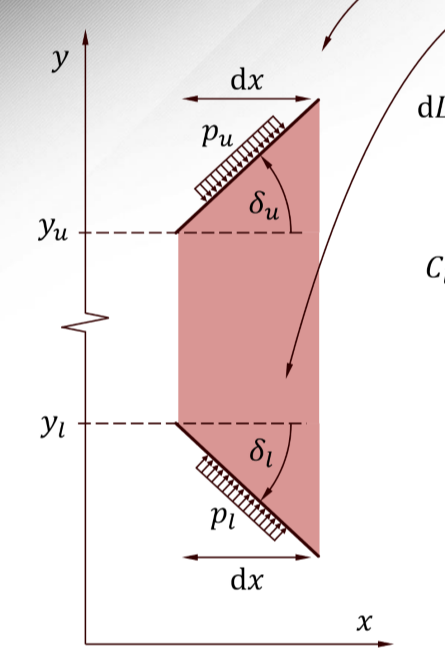
Is this a thin airfoil?
No (Why? because it has a blunt nose!) (Groot will KILL YOU if you get this wrong)

Is this a thin airfoil?
Yes (because it has a sharp nose)
Cones beta angle will be smaller because of what 2 factors?
3D relieving effect, and flow behind the cone is non uniform
immediately behind the shock created by a cone you can assume it is ___ and ____?
steady and uniform

Is this a thin airfoil?
No (it has a blunt nose)
Shocks coming off of thin airfoils are going to be _____ and not ____
oblique and not bowed
T or F: If you have a blunt body, you end up with a bow shock somewhere in front of the stagnation point
T (all blunt bodies will create a bow shock eventually)
Which assumptions do we use for prandtl-meyer?
everything except isentropic and reversible
What laws do we need to derive the prandtl-meyer relation?
all 3
Compression shocks are ___
irreversible
expansion shocks are ____
non-existent (destroys entropy, violates 2nd law of thermo)
Direction of vorticity
Determined by the right hand rule
T or F, the boundary layer is NOT adiabatic
T (boundary layer have some heat dissipation due to viscous effects)
The gradient of entropy points towards the ___ every time?
body (because velocity is always going to eventually become parallel to the body, the change in entropy is perpendicular to velocity)
T or F: velocity near the symmetry line is always smaller than when it is far away
true (because of viscous effects and boundary layer slowing down the flow)
T or F: moving shocks are always unsteady
T (moving shocks are by definition unsteady always)
T or F: shocks are always unsteady
F (you can have a stationary shock like for a wind tunnel)
If Prandtl-Meyer function were valid in the case of a trivial solution, it makes the most physical sense that ___?
straight streamtubes should support sonic flow
What is the definition of the camber line?
the midpoint between upper/lower surface in x-y frame

Tick the single box that indicates the fundamental law that forms the basis for the transport equation for the density. Options are Mass conservation, Newton’s 2nd law, or 1st law of thermodynamics
Mass conservation

Tick the single box that indicates the fundamental law that forms the basis for the transport equation for the flow velocity. Options are Mass conservation, Newton’s 2nd law, or 1st law of thermodynamics
Newton’s 2nd law

Tick the single box that indicates the fundamental law that forms the basis for the transport equation for the specific internal energy. Options are Mass conservation, Newton’s 2nd law, or 1st law of thermodynamics
1st law of thermodynamics

Tick the single box that indicates the fundamental law that forms the basis for the transport equation for the specific kinetic energy. Options are Mass conservation, Newton’s 2nd law, or 1st law of thermodynamics
Newton’s 2nd law

Tick the single box that indicates the fundamental law that forms the basis for the transport equation for the specific total energy. Options are Mass conservation, Newton’s 2nd law, or 1st law of thermodynamics
1st law of thermodynamics
What 4 things do we assume to use the method of characteristics in specific form
Adiabatic, Irrotational, Inviscid, and steady

Briefly explain what the statement “(V dot nabla) s” means
entropy change in the flow-velocity direction (aka the streamline) aka (Velocity dotted with the gradient of the entropy)

What conditions are necessary for ( V dot nabla) s = 0?
steady, adiabatic, and inviscid flow
With the change from irrevesible requirement to irrotational, only ____ and ____ are anisentropic
boundary layers and flow behind curved shocks

Consider the flow through a (strong) stationary shock wave. What conditions are required for (V dot nabla) s to equal 0
inviscid flow
What assumption(s) are necessary to assume vorticity to be constant along streamlines:
steady flow, barotropic flow, irrotational flow
Assume that the velocity vector V points to the left and the vorticity vector points out of the page. What is the direction of the entropy gradient delta s?
down
Crocco’s theorem tells us these flow condition(s) imply isentropic flow (options are steady, adiabatic, irrotational, or reversible flow)
steady, adiabatic, and irrotational

In which flow regime(s) do we find the maximum entropy?
G

In which flow regime(s) do we find the minimum entropy?
A, B, C, D

Tick the flow region(s) that support rotational flow
E, F, and G

What is the direction of the entropy gradient, nabla s, in the region(s) of the diagram that supports rotational flow?
perpendicular to the direction of streamlines and upward

In which direction does the vorticity vector point?
out of the page

What is the delta? Options: initial mach-wave angle, terminating Mach-wave angle, flow-deflection angle with respect to an arbitrary horizontal coordinate, flow-deflection angle with respect to the flow immediately upstream of the considered compression/expansion fan
flow-deflection angle wrt flow immediately upstream of the considered compression/expansion fan

What determines the sign of delta?
whether the flow is compressed or expanded

Can we use the Prandtl-Meyer equation to solve subsonic-flow problems and why?
No (still working on the why part)
the method of characteristics, in the specific form in which we derived and applied it, is restricted to
steady, adiabatic, irrotational, inviscid flow
Pick one or more applicable answers for the method of characteristics from the following interdependent options: (2D flow, axisymmetric flow, full 3D flow)
2D flow
Pick one or more applicable answers that we can use the method of characteristics on from the following independent options: (subsonic, sonic, or supersonic flow)
supersonic
Is the method of characteristics valid for the calculation of the flow through a strong shock wave? why?
no because the method of characteristics requires isentropic flow and strong shocks are anisentropic

In the expressions for the Riemann invariants: K = nu +- delta, what is delta?
the direction of the flow with respect to an arbitrary horizontal (x) component
In our derivation of the Method of Characteristics, we approximate Mach waves as (increasingly more) piecewise-linear line segments. In which of the unknown variables does this approximation produce an error?
Node locations only, the resulting M, delta, and thermodynamic variables are exact

Using exact theory, calculate the pressure coefficient corresponding to region 5, Cp,5
?
What does it mean for a pressure coefficient to be negative
this means the flow is in an expanded state versus the freestream.
In the definition of Cp, why do we use the freestream, dynamic pressure Q infinity?
this is inherited from incompressible flow. Cp = 1 corresponds to stagnation in incompressible flow only (as Mach tends towards zero Cp tends to 1)
Next, let’s discuss the flow downstream of the trailing edge. An educated guess is that the flow downstream of the TE is aligned with the freestream direction. Based on the given direction, how should the slip line be deflected to improve our assumption for the slip line’s direction
Upwards
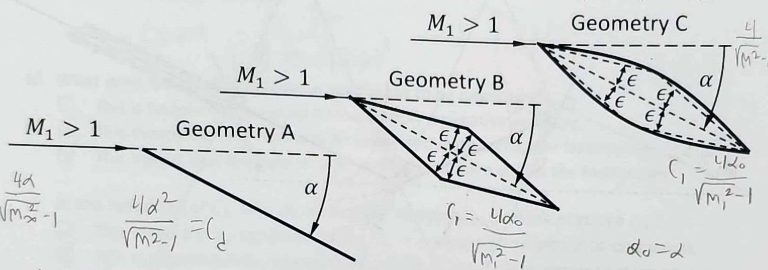
Using thin airfoil theory consider the geometries shown below and assuming M1 and angle of attack are the same for all, how do the lift coefficients of these airfoils relate? Explain
C1,A = C1,b Since the geometry can be simplified to flat plates, they share the same Cl relying only on alpha and is independent of camber
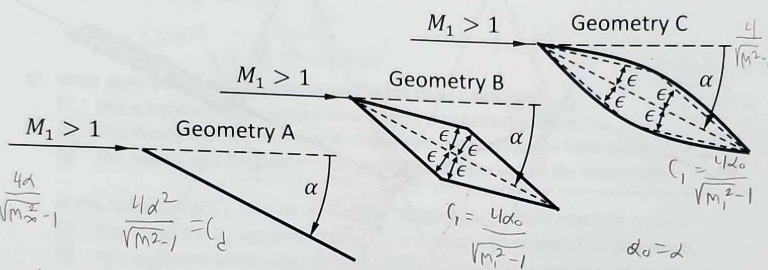
Using thin airfoil theory consider the geometries shown below and assuming M1 and angle of attack are the same for all, how do the drag coefficients of these airfoils relate?
Cd,A < Cd,b < Cd,C because drag depends on camber and thickness for complex geometry. Since all contributions are positive, B and C are greater than A
What assumptions do we need to use thin airfoil theory?
All flow deflection angles are small (imposed either by the geometry or alpha and irrespective of whether the deflections are concave or convex)
If the thin airfoil assumption is/assumptions are justified, what can we say about the angles of shock waves and expansion fans? They:
all collapse down to Mach angles, which are not necessarily close to 0 degrees.

Can we treat the airfoil below as a thin supersonic airfoil?
No (it has a blunt nose)

In the formula for the pressure coefficient corresponding to thin airfoil theory: Cp = 2delta/sqrt(M²-1). Which Mach should be used?
The freestream mach number (because the M will vary infinitesimally throughout the flow field)

The zero reference for the flow deflection angle delta:
the freestream direction, because subsequent deflections add up to the deflection with respect to the direction of the freestream
Change in entropy through Mach waves is …?
zero because Mach waves are isentropic
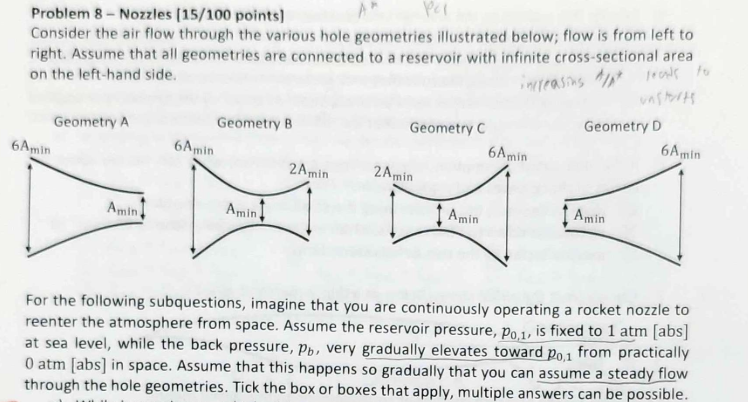
While increasing pb, which of the geometries will support underexpanded flow last?
A (because
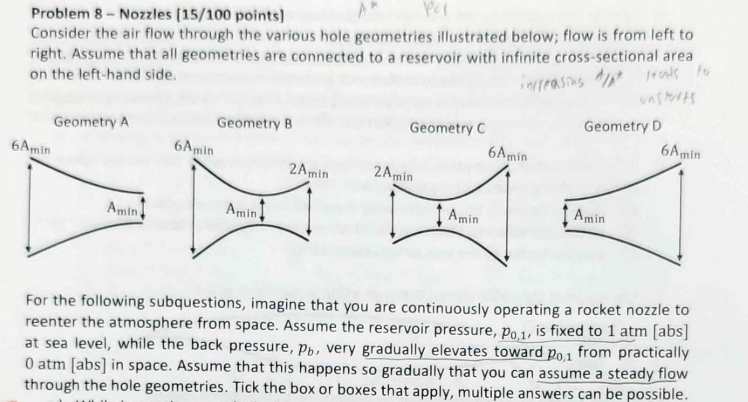
while increasing pb, which of the geometries will unstart last?
A
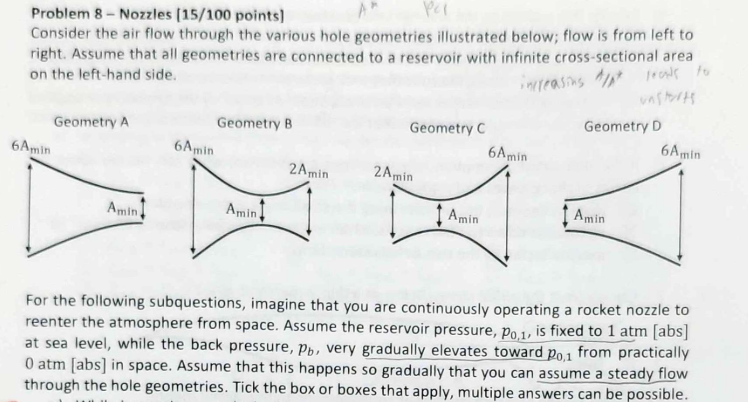
While increasing pb, which of the geometries will support choked flow last?
C and D
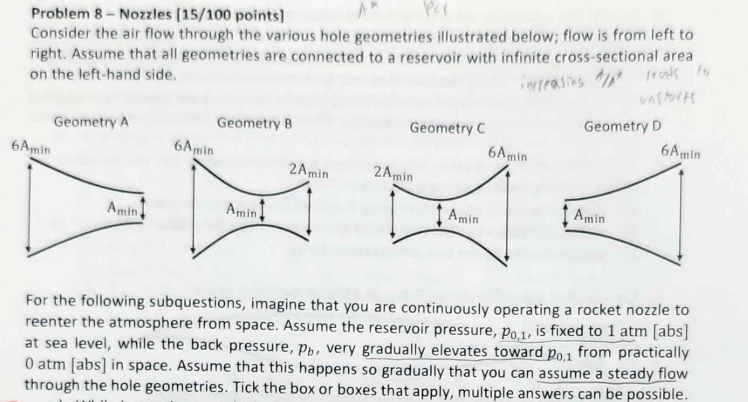
while increasing pb equally slowly for each of the geometries and setting Amin equal for all geometries, which of the geometries do we expect to have drained the reservoir the most as we land at sea level?
C and D
What column of NACA 1135 can you NOT use to calculate for a pitot tube problem
2nd to last column (it doesn’t account for the anisentropic effects of a shock)